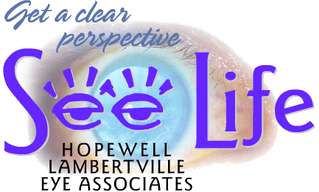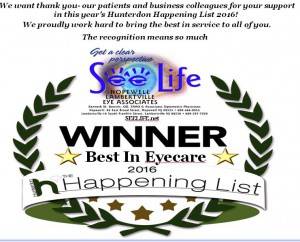
When Blue Light Strikes1
Our eyes are designed specifically to process light and it’s difficult to think that over the course of a lifetime that light damages them. Here is the key thought: an “Excess” of high-energy light. Exposure to all types of visible and non-visible light happens continuously and it has a direct impact on our body and mind, some positive, some negative. It’s impossible to stop the transmission of light or to know which is the most valuable for our well-being. But, based on what we’ve learned, we can certainly filter what experts have learned as potentially damaging high-energy visible light and prevent it from harming us over a lifetime.
This article will emphasize the pros and cons of blue-violet and blue-turquoise light. That’s because as part of the digital age, it is important to know what we are exposed to when we use digital devices. Blue light has become a topic that professionals and media are talking about, mainly HEV light emitted from digital devices. Is this type of light dangerous? What are the risks?
Blue light, in its natural form, over a range of certainly wavelengths is necessary for many reasons: full color and photopic-vision, melatonin/serotonin regulation, body temperature, mood, etc.
The light that enters our eyes from the sun is essentially “white light”, equally composed of all the wavelengths that make up the colors we see. However, approximately 25% to 30% of white light is blue light. UV generally affects the front of the eye, blue light the retina though UVA and is problematic early in life when before the lens produces the chemicals needed to absorb UVA and UVB.
To better understand UV’s and its effects just know that the sun emits invisible ultraviolet radiation in the form of UVA, UVB and UVC rays. While UVC rays never penetrate the ozone layer, UVA and UVB rays do. UVA and UVB rays cause photo damage to the skin, leading to accelerated aging and an increased risk of skin cancers. The eyelid skin is the thinnest and most sensitive skin on your body. As a result, this is often the first area on your face to show change from sun damage and aging.
How Does UV Light Affect Eyesight?2
Both long- and short-term exposure to UV radiation, from both the sun and digital technology, can harm the eyes, affect vision, and compromise overall eye health. There are several eye diseases and conditions caused or aggravated by exposure to UV radiation, such as:
Macular Degeneration. Macular Degeneration (AMD) is caused by damage to the retina over time and is the leading cause of age-related blindness. Extended exposure to UV light increases your risk of developing macular degeneration.
- Cataracts. A cataract is a clouding of the eye’s natural lens -- the part of the eye that focuses the light we see. UV light, especially UV-B rays, increases your risk for certain types of cataracts. It is estimated that 10% of all cataract cases are directly attributable to UV exposure.
- Pterygium. Often called “surfer’s eye,” pterygium is a pink, non-cancerous growth that forms on the layer of conjunctiva over the white of your eye. UV light from the sun is believed to be a factor in the development of these growths.
- Skin Cancer. Skin cancer in and around the eyelids is also linked to prolonged UV exposure.
- Photokeratitis. Also known as corneal sunburn or “snow blindness,” photokeratitis is the result of high short-term exposure to UV-B rays. Long hours at the beach or skiing without proper eye protection can cause this problem. It can be very painful and may cause temporary vision loss.s the thinnest and most sensitive skin on your body. As a result, this is often the first area on your face to show change from sun damage and aging.
Blue Light
Blue light wavelengths are part of the electromagnetic visible spectrum. These waves emit energy, the shorter the wavelength, the higher the energy. It is this energy, over long periods of time that researchers have suggested we need adequate protection.
You know it as ultraviolet light, the wavelengths between 290nm and 380nm are (UVB/A) and 380nm to 500nm are (blue light). Because blue light has a very short wavelength, it produces a higher amount of energy than the other wavelengths of the visible spectrum. Some studies have shown that over time, exposure to the blue light could cause serious long-term damage to our eyes.

While we know that digital devices emit higher levels of blue light and we hold those devices close for long periods of time. We should consider managing exposure to blue light. We have some potential fixes: blue light attenuating lenses that can reduce blue light from screens by dimming the screen and of course, reducing screen time.
Sunlight has the most blue light exposure. We know not to look directly at the sun since even short periods of exposure can easily cause solar retinopathy due to high-intensity solar radiation. This means that we should wear blue light protection indoors and blue light and glare protection outdoors, to avoid discomfort and photochemical damage.
LEDs and Blue Light
LED’s (Light Emitting Diodes) have been a great innovation for office and home lighting as well as computer screens and monitors. This has allowed thinner, brighter, lighter, and much more energy efficient devices. The advantages of this technology has been a dramatic change in the lighting around us. But not everything is an advantage.
These lights are incorporated in different digital devices such as smartphones, PC’s and TV’s.
LED radiation has a downside to our health. Depending on the distance from our eyes to these light sources, and the frequency e.g., the time we spend in front of the screen and the average distance from our eyes to the screen of a computer (about 27 inches, to a tablet or about 21 inches) and a mobile screen that about 14 inches.
Light, For Vision and Non-Vision Functions
Did you know that the eyes, being the receptors for light, help your body’s other natural functions? In the list below we see that vision provides color and images but also with two eyes together, provides the opportunity for binocular vision. That allows 3 Dimensional vision with depth perception used for orientation. In addition, the contrast of colors, shades and shadows helps define edges and that adds to binocularity for adaptation and mobility. All of this is combined for complete visual acuity.
|
Visual Use of Blue Wavelengths
|
Non-Visual Use of Blue Wavelengths
|
The ganglion cells of the retina are constructed to receive a variety of the longer blue wavelengths. With those, the body regulates sleep, mood, body temperature, heart rate and some hormone balance. Because of this, blue light has been used to treat seasonal affective disorder for some.
However, while we must allow blue light to provide the good blue wavelengths, we are concerned for those that can potentially damage the eye. So, a knowledge of both is in order.
Beneficial VS. Non-Beneficial Blue Light
Blue light is everywhere, most exposure comes from sunlight. The shorter, high energy blue wavelengths collide with air molecules causing blue light to scatter which makes the sky appear blue. These wavelengths vibrate more easily than longer wavelengths. This kind of unsteady light produces glare that can diminish visual contrast and affect sharpness and clarity of vision.
It contributes to eyestrain, headaches, physical and mental fatigue produced by many hours sitting in front of computer screen or other devices. This means that augmenting protection to our eyes’ natural filters can provide sufficient protection against blue light rays from the sun and electronic devices.
In its natural form our body uses blue light from the sun to regulate your natural sleep and wake cycles. This is known as your “circadian rhythm.” Blue light also helps to boost alertness, heighten reaction time, elevate mood, hormone production, and increase the feeling of well-being. Blue light therapy has been use with positive results in treating certain mood disorders.

Exposure to Blue Light
The Lighting Research Center at Rennselaer Polytechnic Institute stated that, “…it takes an average of 13 hours in front of a computer screen to equal the amount of 15 minutes of sunlight blue lux. One hour of direct LED lighting equals to also 15 minutes of sunlight blue lux” Obviously, outdoors requires more protection but that suggests we teach patients the opportunities for outdoor and indoor eyewear. You might ask yourself, “What is your exposure and that of your customers?”
 Image: Zeiss
Image: Zeiss
How many hours do you spend in front of a digital device?
Most of us, in a normal day, spend more than 2 hours staring at a digital screen, whether it is work related or just for fun. Some studies stated that 60% to 70% of people spend more than eight hours a day in front of a digital device. With the potential for these devices to emit high-energy visible (HEV) blue light, which simply states that we all could benefit one way or the other from learning about protection.
In fact, some schools are implementing a “Google Classroom”, a new way of learning. This means that, students will spend more time in front of the computer and digital devices. This gives us another reason to educate patients about the prevention of the accumulation and the importance of filtering HEV light. Since screen time is popular at even earlier ages, limiting screen time and/or protecting younger eyes is essential.
Protect Eyes from Blue Light?
Take precaution against the effects of blue light, whether out in the sunlight or indoors. Consider the products from different companies that have developed lens products designed to filter HEV and UV light. Visit websites that describe the opportunities for blue light attenuating lenses, some of which are listed here…TheraBlue Lenses (Luzerne Optical Laboratory), Crizal Prevencia No-Glare lenses by Essilor, HOYA Recharge, Zeiss DuraVision Blue Protect, Vision-Ease Clear Blue Filter, Transitions and BluTech Lenses available from a number of vendors. This new generation of lenses creates opportunities for the digital age.
Conclusion
Blue light, is necessary for our health and well being in the right wavelengths and amounts. Be aware of the visual and non-visual direct effects of blue light. An educated eye care professional and patient can achieve the best balance of prevention and protection.

Marlon Lopez, ABO, NCLE, Marlon is finishing an Ophthalmic Science Degree at Raritan Valley Community College and is an Optical Apprentice at Hopewell Lambertville Eye Associates. He has worked in the field for eight years and started his career with his CPO “Certified Para-Optometric” certification, New Jersey Society of Optometrists. He has enjoyed interacting recently with patients with a different perspective from studying lens types, anatomy of the eye, coatings and types of progressives.
Read more
Citations:
- https://www.2020mag.com/article/when-blue-light-strikes
- http://visionsource.com/blog/how-does-uv-light-affect-eyesight
Article References:
- Holzman, David C. “What’s in a Color? The Unique Human Health Effects of Blue Light.” Environmental Health Perspectives 118.1 (2010): n. pag. Web.
- Dai, Tianhong, Asheesh Gupta, Clinton K. Murray, Mark S. Vrahas, George P. Tegos, and Michael R. Hamblin. “Blue Light for Infectious Diseases: Propionibacterium Acnes, Helicobacter Pylori, and Beyond?” Drug Resistance Updates 15.4 (2012): 223-36. Web.




